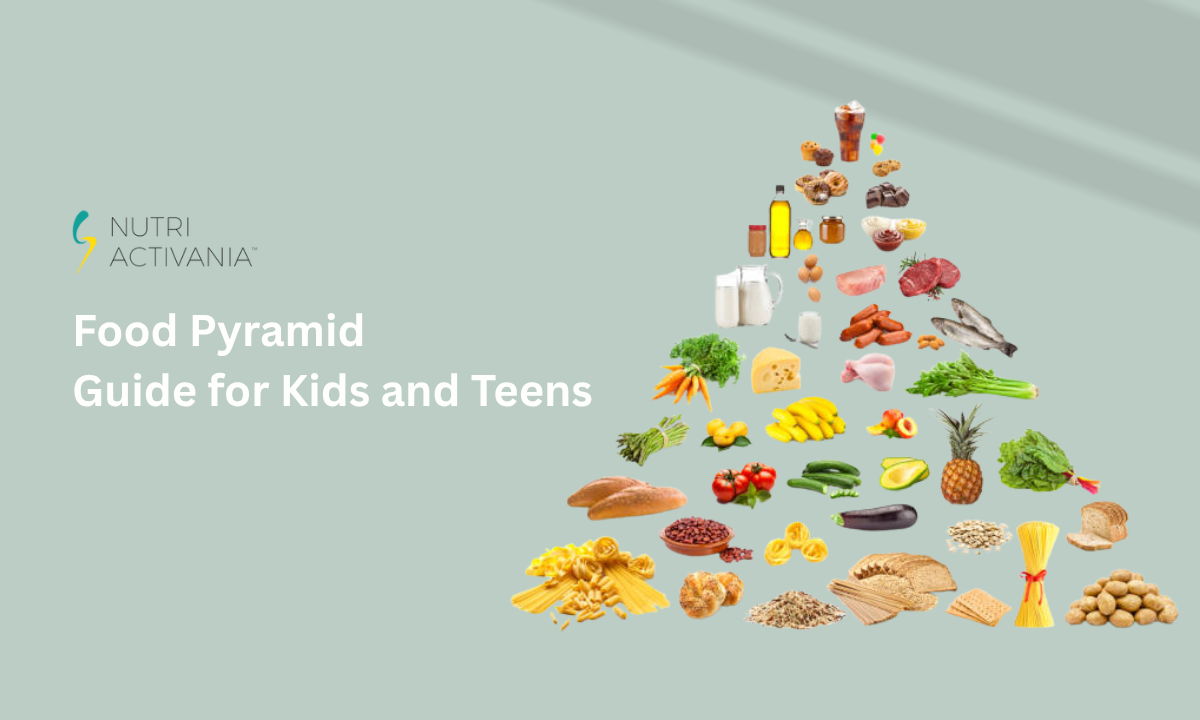
The food pyramid is like a roadmap that shows you exactly how much of each food type you should eat every day to stay healthy and energetic.
I’m Avni Kaul, and I have spent years helping kids, teens, and their parents understand nutrition in the simplest way possible.
Many young people struggle with choosing the right foods, especially when they are surrounded by junk food options everywhere.
The food pyramid makes healthy eating easy to understand; no complicated rules, just a simple visual guide.
Working with the best dietitian and top nutritionist in Delhi can help you and your family understand this guide even better.
But there’s one surprising food group that most kids and teens don’t eat enough of, and it’s affecting their growth and energy levels more than you’d think.
Let me explain the food pyramid’s meaning.
It’s a visual tool that helps you understand portion sizes without having to count calories or measure everything you eat.
Let me break down each level of the food pyramid guide so you know exactly what to eat.
This simple structure helps you visualize what a balanced plate should look like at every meal.
There are actually different food pyramid types designed for different purposes and populations.
As a top nutritionist in Delhi, I help families choose which pyramid type suits their specific needs and health conditions. For most kids and teens, the traditional pyramid works perfectly as a starting point.
The role of the food pyramid in nutrition is especially important when you’re young and still growing.
Your body is building new cells, growing taller, and developing stronger bones, and your brain is maturing too.
All of this requires proper nutrition – not just any food, but the right balance of nutrients.
Following the food pyramid ensures you get protein for muscle growth, calcium for bone development, carbohydrates for energy, and vitamins for overall health.
Skipping any level of the pyramid means your body might miss out on nutrients it desperately needs during these crucial years.
Using the food pyramid for a balanced diet isn’t complicated; let me show you how it looks in real life.
Here’s what a day of eating based on the pyramid might look like:
| Meal Time | Foods from Each Level |
|---|---|
| Breakfast | Whole wheat paratha (Level 1), Paneer (Level 3), Milk (Level 4), and Apple (Level 2) |
| Mid-Morning | Banana (Level 2), Handful of nuts (Level 3) |
| Lunch | Brown rice (Level 1), Dal (Level 3), Mixed vegetables (Level 2), and Curd (Level 4) |
| Evening | Whole grain toast (Level 1) and Peanut butter (Level 3/5) |
| Dinner | Roti (Level 1), Chicken/Egg curry (Level 3) and Salad (Level 2) |
Notice how every meal includes foods from multiple levels, with more portions from the bottom levels.
Let me share the biggest mistakes I see young people making with their diet.
Avoiding these mistakes makes following the pyramid much more effective.
These simple changes make pyramid-based eating feel natural, not forced.
While the food pyramid is a great general guide, every person’s needs are slightly different.
The role of a nutritionist is to help you understand how to modify the pyramid for your specific situation.
A nutritionist helps you apply the pyramid principles to your unique circumstances rather than following it blindly.
Following the food pyramid doesn’t mean giving up all your favorite foods.
It means understanding proportions and making smarter choices most of the time.
You can still enjoy pizza, but maybe add a side salad and not eat it every day.
Ice cream is fine occasionally; it’s a Level 5 food, so small amounts on special occasions fit perfectly.
The goal isn’t perfection; it’s consistency with making choices that follow the pyramid most of the time.
The food pyramid is one of the simplest yet most effective tools for understanding balanced nutrition, especially for kids and teens who are still growing.
Following its guidance ensures you get all the nutrients your body needs without complicated meal planning or restrictive diets.
If you are struggling to implement these principles or need personalized guidance based on your specific health needs, consulting with the best dietitian and top nutritionist in Delhi can make all the difference.
At Nutri Activania, we help young people and their families understand nutrition in practical, sustainable ways that fit into real life.
Remember, building healthy eating habits during your childhood and teenage years sets the foundation for lifelong wellness, and the food pyramid is your roadmap to get there.
Q1: Do I need to follow the food pyramid exactly every single day?
Not necessarily. Think of it as a weekly guide rather than a daily rule. Some days you might eat more from one level, but over the course of a week, aim to follow the proportions the pyramid suggests.
Q2: What if I’m a vegetarian? Does the pyramid still work?
Absolutely! Just replace meat proteins with plant-based proteins like dal, beans, tofu, paneer, and nuts. The pyramid structure remains the same; only the specific foods within Level 3 change.
Q3: How do I know what counts as “one serving” from each level?
A serving is roughly 1 slice of bread, 1 cup of rice, 1 medium fruit, 1 cup of vegetables, 1 cup of milk, or a palm-sized portion of protein. Your nutritionist can help you understand portions for your age.
Q4: Can following the food pyramid help me with sports performance?
Yes! Athletes might need slightly more from Levels 1 and 3 (carbs and protein), but the basic pyramid structure ensures you get all nutrients needed for energy, recovery, and performance.
Q5: What about junk food? Is it completely forbidden?
Not forbidden, just limited. Junk food sits at Level 5, which means small amounts occasionally are fine. The problem is when Level 5 foods replace nutritious foods from other levels regularly.

Avni Kaul is a leading Dietitian & Nutritionist in Delhi NCR and the Founder of Nutri Activania. She holds a Master's Degree in Food and Nutrition from the University of Delhi and is a Certified Diabetes Educator from Project Hope and the International Diabetes Federation.
Her extensive experience includes serving as a Leicester Mamma's Ambassador, trained in Lactation Counselling with the NHS, United Kingdom.
Ms. Kaul specializes in key areas such as Infant and Young Child Feeding Practices, Pre- and Post-natal Diets, Fat Loss, Muscle Gain, and Holistic Health and Nutrition.